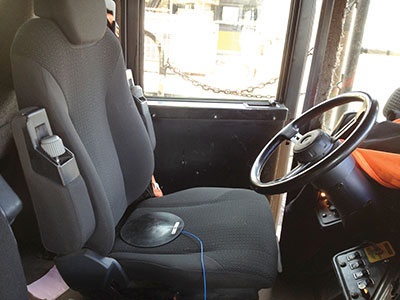
Features
Columns
Education
Practical Approach to Ergonomics
Expert advice on how to prevent the risk of injury on the job site.
June 14, 2013 By Steve MacDonald
Workplace injuries have considerable impact on both employers and employees and affect all areas of operations.
Workplace injuries have considerable impact on both employers and employees and affect all areas of operations. Musculoskeletal disorders (MSD) account for more than one-third (34%) of all injuries in the aggregates industry. Machinery operators such as heavy equipment operators and truck drivers, maintenance personnel such as mechanics, millwrights, welders, and electricians, as well as labourers, have a higher risk of injury. Office workers such as dispatchers and sales managers can also be affected.
In order to reduce the likelihood of MSD injuries, a practical ergonomics approach should be taken. This strategy includes recognizing and assessing for ergonomic risk factors and then implementing and monitoring ergonomic interventions.

|
|
| Vibration in the cab needs to be frequently measured in order to manage the risk of injury to an operator. Advertisement
|
Recognizing Ergonomic Risk Factors
It is important to identify ergonomic risk factors in the workplace. The three main risk factors include force, repetition, and awkward or static postures. Other hazards include psychosocial factors (e.g., workload, job satisfaction and stress) and environmental factors (e.g., temperature and vibration). Workers may be exposed to a single risk factor during a specific job task or they may be exposed to multiple risk factors, thereby significantly increasing the risk of injury.
Vibration is a major risk factor in the aggregates industry due to the mechanized processes and delivery of materials to customers. Vibration can be transmitted into the body via two mechanisms: hand-arm vibration (HAV) is transmitted by holding vibrating controls and tools whereas whole-body vibration (WBV) can be
transmitted into the body through standing – on vibrating platforms, for example – or sitting in heavy machinery and trucks.
When considering ergonomic risk factors, you may be overwhelmed by the challenge of looking at every job class and job task. Therefore, the employer and Joint Health and Safety Committee (JHSC) should focus on high-risk jobs. A simple method of recognizing these high-risk jobs is to look for injury trends. The simplest trending method involves reviewing injury statistics. When reviewing, look for common injury types, injuries associated with specific job titles and injuries that occur during specific tasks.
Employee discomfort is typically underreported or is considered to be “part of the job.” However, discomfort may be a precursor to more serious MSD injuries. To capture this, encourage employees to speak up at meetings, provide them with anonymous employee comfort surveys or implement a comment card system for ergonomic concerns.
Assessing Ergonomic Risk Factors
Once a specific task or job class has been identified as having a high potential for injury, it must be assessed to determine all the ergonomic risk factors. There are numerous methods and tools that have been created to assist the employer and JHSC in determining these risk factors. These include ergonomic checklists, MSD hazard assessments and job safety analyses. Ergonomic checklists are simple to use and ensure that a thorough analysis of risks is conducted.
Regardless of which assessment method is chosen, it is important to document the following items during an assessment:
- job type
- relevant job tasks
- tools used
- the weight of items lifted or handled
- how often items are used
- items that are pushed and pulled
- heights of objects
- surfaces used during the tasks
- reach distances
Taking plenty of photographs or even a video during the assessment is an easy way for the assessor to ensure they have collected all of the information they need. Once the information is gathered, it can be used to determine if the workplace setup meets the needs of the worker(s).
More formalized ergonomic assessment evaluation methods are available. These tools typically require additional training to understand their use and the outcomes of each method. Several examples include the Rapid Upper Limb Assessment, Rapid Entire Body Assessment, the National Institute for Occupational Safety and Health (NIOSH) lifting equation, and the Liberty Mutual manual materials handling tables.
It is important to regularly review relevant standards, codes of practice and regulations throughout the ergonomic review to facilitate appropriate ergonomic interventions and to control hazards.
Implementing and Monitoring Ergonomic Controls
Prevention strategies must be implemented following a thorough review of ergonomic hazards associated with a work task. Since many ergonomic strategies are implemented reactively to injuries, workplaces should strive to become proactive in preventing MSDs. The following are some examples of implementation strategies that would be beneficial in your workplace:
- Implement a stretching program
- Train
- Rotate jobs
- Create a program for working in the heat and one for working in the cold
- Consider measuring vibration exposure
Once an ergonomic intervention has been implemented, the process or job task should continually be monitored for additional means of improvement and for reinforcement.
A Practical Approach to Ergonomics
Improving health and safety through a practical ergonomics approach is important to being competitive in the ever-evolving aggregates industry. There are numerous benefits for both the employer and the employee by transitioning from being reactive to injuries to being proactive in preventing them. By recognizing ergonomic risk factors, assessing job tasks for risk factors, and then controlling and monitoring implementation strategies, workplaces can actively work towards minimizing physical and environmental stresses on the body and can benefit from ergonomic interventions.
Steve MacDonald, MSc, HBSc, is a Health and Safety Specialist with Golder Associates Ltd., based in the company’s Sudbury, Ont., office. Contact him at 705-524-6861 or steve_macdonald@golder.com.
Print this page